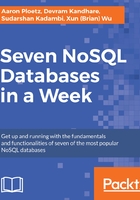
Conventions used
There are a number of text conventions used throughout this book.
CodeInText: Indicates code words in text, database table names, folder names, filenames, file extensions, pathnames, dummy URLs, user input, and Twitter handles. Here is an example: "Now is also a good time to change the initial password. Neo4j installs with a single default admin username and password of neo4j/neo4j."
A block of code is set as follows:
# Paths of directories in the installation.
#dbms.directories.data=data
#dbms.directories.plugins=plugins
#dbms.directories.certificates=certificates
#dbms.directories.logs=logs
#dbms.directories.lib=lib
#dbms.directories.run=run
When we wish to draw your attention to a particular part of a code block, the relevant lines or items are set in bold:
# Paths of directories in the installation.
#dbms.directories.data=data
#dbms.directories.plugins=plugins
#dbms.directories.certificates=certificates
#dbms.directories.logs=logs
#dbms.directories.lib=lib
#dbms.directories.run=run
Any command-line input or output is written as follows:
sudo mkdir /local
sudo chown $USER:$USER /local
cd /local
mv ~/Downloads/neo4j-community-3.3.3-unix.tar.gz .
Bold: Indicates a new term, an important word, or words that you see onscreen. For example, words in menus or dialog boxes appear in the text like this. Here is an example: "To create a table, click on the Create table button. This will take you to the Create table screen."